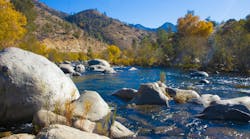Highway Storm Water Runoff: BMP Design Considerations
Seshadri Iyer is senior water resources engineer and Mark McCabe is storm water engineering program manager for URS Corp. Iyer can be reached at 757/499-4224 or by e-mail at [email protected]. McCabe can be reached at 614/464-450 or by e-mail at [email protected].
undefinedThe principal objectives of best management practice (BMP) designs in the highway environment are to improve water quality, attenuate water quantity, control costs, minimize maintenance, meet regulatory requirements, and be aesthetically pleasing and integrated into the project development process (PDP) for departments of transportation (DOTs).
The challenges faced by those involved in highway drainage design around the country in meeting these objectives are compounded by the difficulty of selecting the proper BMPs for post-construction and the availability of land in highly developed urban environments. These challenges also apply to BMP retrofit designs. The process is further complicated by the use of alternative design methodologies, varying regulatory and permit requirements, differing watershed guidance, and local- or site-specific limitations and requirements.
Standardization of BMP device design for the highway environment is the first priority in addressing these challenges and producing design consistency that will meet regulatory issues and be successfully incorporated into the project development and design process.
Environmental Permit Requirements
DOTs have the potential responsibility to control storm water runoff from a network of roads and other facilities over a very large area, where they might be faced with compliance under multiple surface water quality regulations. The goals of these regulations often result in an inconsistent network of compliance requirements.
The following is a brief list of environmental rules that may regulate DOT projects and should be considered as site-specific concerns during the BMP selection process.
- NPDES Phase I & II storm water discharge permits;
- NPDES Phase I & II construction permits (for activities of 5 acres or more under Phase I and 1 acre or more under Phase II);
- Sections 401 and 404 Wetland permitting;
- Threatened and endangered species regulations;
- State-specific regulations targeting watershed protection such as nutrient-sensitive streams, outstanding water resources, drinking water supplies, fishery waters, coastal waters, etc;
- State-specific regulations regarding construction activities;
- Local water quality ordinances or goals; and
- Total maximum daily loads (TMDLs) and waste load allocations (WLAs).
It should be noted that, while most DOTs are not subject to local ordinances, they may choose to apply local water quality goals under other programs such as Context Sensitive Solutions or other public outreach. DOTs may benefit from the local knowledge, experience and understanding of performance efficiencies of different BMPs that work best in local jurisdictions.
Issues
There has been much discussion of the unique issues in the management of storm water runoff from linear projects, both large and small scales. The most important issues are related to vertical and horizontal alignment, drainage and safety requirements (i.e., removing surface runoff from the pavement), and other features dictated by strict guidelines from state and federal agencies that often cannot be readily modified or manipulated to benefit storm water management goals.
With the build-out of most transportation corridors, the purchase of additional right-of-way for “traditional” BMPs such as dry ponds, retention basins, constructed wetlands and other practices is becoming cost prohibitive due to land values. For this reason, DOTs are seeking innovative strategies to comply with water quality regulations. Surface water runoff and drainage characteristics in highway systems are quite different from those in site development projects, particularly in terms of water quality. Generally, the greater the average daily traffic (ADT), the more polluted the surface water runoff. In addition, deicing agents, salt and sand, used as a safety precaution for the traveling public, contribute to the increased level of pollutants in the storm water runoff.
Additionally, distinctive geographic regions within a state, such as mountains, plains or coasts, present unique topographic site characteristic challenges on a regional scale, including soil, topography, weather and even political issues. Such geographic regional challenges combined with Phase I and II storm water and construction discharge permit requirements present DOTs with project planning and design challenges for implementing post-construction BMPs.
In the selection and placement of storm water BMPs, the linear development projects are subject to a public participation and acceptance process that is unheard of in a private site development project. Further, in urbanized areas the drainage from highways may or may not be separate from the drainage of the adjacent development. DOTs often spend additional money on drainage to keep these flows separate. Ideally, developers and agencies should work together to manage storm water so responsibility for cost and compliance is proportional to drainage area contributing to the runoff. Additionally, the generally larger surface area of a private development affords more flexibility for BMP selection and placement for storm water management. Highway facilities such as rest areas, district/division buildings, garages and sand/salt storage may also have limited space on the property for storm water management. This is directly related to the cost of property. One potential solution is to modify or retrofit current quantity control devices to provide water quality benefits. Another possible alternative is to look for ways to partner with DOTs as a means of filling in “gaps” in the storm water management program, outfall inventory or illicit discharge detection program.
Design Criteria
The primary criteria of highway design have been to remove runoff from the pavement surface quickly and efficiently. This initiative has evolved to include concerns of water quality associated with highway runoff, and its importance is highlighted with the passage and implementation of the Environmental Protections Agency’s (EPA) Phase II NPDES storm water program. This has led to new and evolving water quality goals associated with the quality and quantity of runoff discharging into receiving water bodies after construction. These requirements are forcing DOTs nationwide to improve the manner in which highway runoff is managed, conveyed and discharged. To select a BMP, designers must understand its efficiency to remove the pollutant(s) of concern. Criteria for selecting BMPs are presented in the literature to assist the engineer in preliminary screening and methods selection. For brevity, the details are omitted here, but the general criteria and considerations are (click here to see figure):
- Type of highway facility—interchanges, intersections, bridges, linear segments and non-linear highway facilities;
- Average daily traffic counts—urban or rural highway sections;
- Type of construction project—new, redevelopment and rehabilitation projects;
- Geographical region—such as mountains, plains and coastal;
- Project location—rural, urban and ultra-urban setting;
- Receiving waters—sensitive waters, protected waters, surface impoundments and reservoirs, natural streams, creeks, ditches and swales. Stream order as it relates to prevention of stream scouring should also be considered during BMP planning, selection and design;
- NPDES Phase II requirements—local water quality and storm water requirements need to be addressed during BMP planning, selection and design. These requirements may be in addition to state requirements and may require BMP modification to meet local rules;
- TMDLs—for approved TMDLs where DOTs have management measures, BMPs should be selected based upon pollutants of concern for the receiving waters;
- Offsite drainage and treatment—in urbanized areas drainage/runoff from the highway/roadway systems may or may not be separate from the drainage of the adjacent development;
- Water quality characteristics of highway surface water runoff—plays a major role depending on the traffic volume/speed. A higher ADT results in higher concentration of pollutants washing off the highways during storm events;
- Differing watershed guidance—note project delineated drainage areas may span more than one hydrologic unit code (HUC) watershed; and
- Site-specific constraints.
Design Challenges
The design of structural BMPs are presented in various literature sources and are not duplicated here. BMP design methodology is the same for linear and non-linear projects, with possible variation in the physical constraints and/or pollutants of concern.
The challenges faced by the DOTs are in the development of methodical design approaches for different types of BMPs to present a consistent set of designs to streamline the review process, minimize constructability problems, and provide ease of post-construction maintenance, safety and security. In general, the design of BMPs at a particular site is controlled by physical factors at the site. The predominant physical factors include: drainage area; infiltration capacity of the soils; slope of the site; depth to groundwater table; and soil bearing capacity to construct dams and provide maintenance access.
With more emphasis on water quality over quantity, most BMPs are volume-based, with their designs based on water quality volume. The design of traditional BMPs can be accomplished using simple rational methods, Manning’s equation, and weir and orifice equations. For routing, a simple storage-indication method (or modified Puls method as it is called) could be created in a spreadsheet. However, the challenges faced by the DOTs, the drainage designs and BMP designs, has become more of an art than science. This stems from the fact that there are numerous hydrologic and hydraulic methods presently available to the drainage engineer through various models and software. There are deterministic steady-state models, dynamic models, stochastic models and a few optimization models that account for uncertainty in parameter estimations. Design solutions resulting from these varying methods are correct but different. No two methods converge on the same set of design parameters. For this reason, standardizing design methods (hydrologic and hydraulic) and construction documents including construction plan package would greatly help the reviewers at DOTs, and in turn they will be able to easily justify construction and maintenance costs and water quality benefits to the general public.
At the time of writing this article, the authors are in the process of reviewing various hydrologic and hydraulic methods available and have not drawn conclusions to present a systematic process to evaluate alternative design methodologies for BMP devices applicable to the highway environment.The following design challenges should be considered during the selection procedures for linear BMPs:
- Geotechnical—natural versus fill areas and groundwater table. During the design process the engineer should consider BMP selection and placement in relation to soil conditions and groundwater elevation at the project site;
- BMP orientation—the orientation and position of the BMP will need to be addressed as the orientation may require right of way and incurring additional costs;
- Surrounding topography—affects hydraulic grade line, inlet and outlet velocities to and from BMPs, and erosion potential;
- Off site drainage responsibility—bypass or separation should both be considered. Local or additional regulatory requirements should be reviewed prior to the final decision;
- BMPs in series—how the components fit together;
- Maintenance and operation ingress and egress;
- Safety—clear zone requirements;
- BMP design should be able to be evaluated for water quality effectiveness and performance; and
- Construction—experienced construction inspectors should be present during construction to address constructability issues, including a photographic log of the construction process and commissioning.
Lessons Learned
BMP selection and design is an evolving practice to implement water quality controls to comply with regulatory drivers. DOTs face unique limitations and design challenges due to the highway’s linear attributes. DOTs should continue to standardize the BMP design process to streamline the review process, minimize constructability problems, increase regulatory compliance, and provide ease of post-construction maintenance, safety and security.
It should be noted that even though this article discusses BMPs for highway/roadway environments, the procedures, processes and approaches are applicable for local road projects, local road redevelopment and rehabilitation projects.


